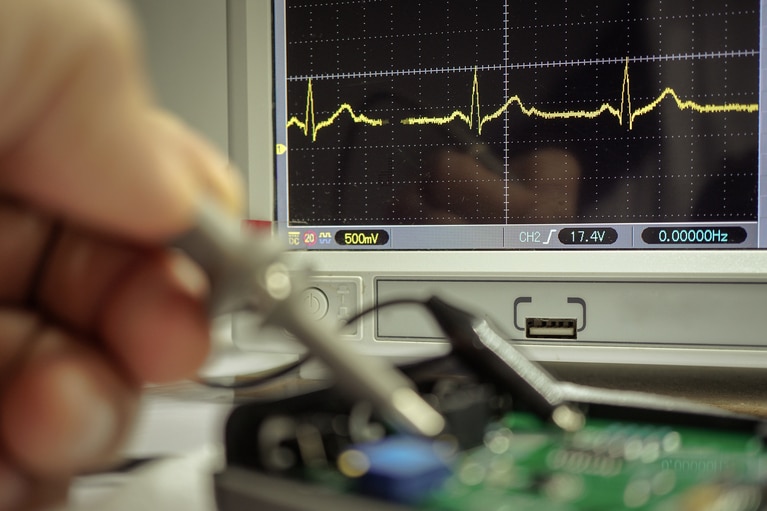
為關鍵任務型應用提供創新的可靠電源解決方案
技術資源合集,旨在教育用戶在航空航太、國防和太空應用中使用模組化電源的優勢
本文為常用術語的便捷參考,可以幫助您理解和掌握測試與儀器行業的複雜術語。
表壓與大氣壓力之和。
熱能最低時的溫度,定義為 0 開爾文,計算結果為 -273.15°C 或 -459.67°F。
交流電;以規律性重複間隔改變方向的電流。
物體或粒子相對於時間的速度變化。加速度計量測該參數(dv/dt)。組織用“g”表示。
一種將機械運動效應轉換為與運動加速度值成比例的電信號的設備。一種感測器。一種換能器。
量測設備的訓示或讀數與被量測名額的實際值之間的接近程度。通常表示為全量程輸出或讀數的 ± 百分比。
聲音的强度。彈性體振動的性質、原因和現象;這些振動產生壓縮波或波前(波陣面),並通過空氣、水、木材、鋼鐵等多種介質傳播。
一個熱力學術語,用於描述溶液中自由離子的錶觀或有效濃度。它與活度係數和濃度相關聯。
物體i的活度(ai)與其摩爾濃度(C)的比值。它是確保熱力學計算正確性的修正因數。該係數取決於離子強度、溫度和其他參數。
單個離子活度係數,陽離子為 f+,陰離子為 f-,無法通過熱力學推導。它們只能通過使用德拜-休克爾(Debye-Huckel)定律對低濃度溶液進行計算。在這種溶液中,離子間的作用力主要取決於離子的電荷、半徑和分佈以及介質的介電常數,而不是離子的化學性質。
另一方面,平均離子活度係數(f±)或鹽的活度可以通過多種方法進行量測,如冰點降低法、蒸汽壓法以及配對的傳感電極。它是單個離子活度係數的幾何平均值:f±=(f+n+f-n-)1/n。
用於連接不匹配部件的機制或設備。
一種將類比信號轉換為等效數位形式的電子設備,可以是二進位程式碼或二進位編碼十進位程式碼。用於動態波形時,取樣速率必須足够高,以防止產生混疊誤差。
標識存儲資訊單元存儲位置的標籤或號碼。
如果函數的取樣速率(fs)低於函數的最高頻率值的兩倍,則頻率呈現不明確。高於(fs/2)的頻率將被折疊回較低頻率,產生錯誤數據。
與純銅配合使用的補償合金,作為 R 和 S 型鉑-鉑銠熱電偶的延長線負極。
鎢與鎢 26% 錸(含有 26% 錸的鎢合金)熱電偶配合使用的補償合金組合,作為 200°C 以下應用的延長電纜。
與鎢 3% 錸(含有 3% 錸的鎢合金)及鎢 150 錸熱電偶配合使用的補償合金組合,作為 200°C 以下應用的延長電纜。
與鎢 5% 錸(含有 5% 錸的鎢合金)及鎢 26% 錸(含有 26% 錸的鎢合金)熱電偶配合使用的補償合金組合,作為 870°C 以下應用的延長電纜。
一種鋁鎳合金,用於 K 型熱電偶的負極(OMEGA ENGINEERING 公司的注冊商標)。
包含字母和數位的字元集。
CPU 的一部分,在這裡對二進位資料進行數學運算。
一種鋁鎳合金,用於 K 型熱電偶的負極(Hoskins Manufacturing 公司的商標)。
儀器的設計,使環境溫度的變化不影響儀器讀數。
換能器周圍的條件(壓力、溫度等)。
換能器周圍空氣的壓力。
與測試設備和儀器接觸的周圍空氣的平均溫度。
一種用於量測電流的儀器。
用於定義電路中電流流動速率的組織; 組織是每秒一庫侖(6.28 x 1018 個電子)。
一種比輸入信號能提供更多的功率的設備,並將輸入信號的主要特徵放大後輸出的裝置。
資料在時域或頻域圖形顯示中的 Y 軸範圍。通常用對數顯示(dB),但也可以是線性顯示。
測得的從最高點到最低點的運動距離,如機械體的振盪或電波形的峰-峰擺動距離。
一種電壓或電流訊號,它是量測參數的連續函數。
將輸入的類比信號電平轉換為二進位數的裝置或電路。
量測和/或顯示空氣流速的儀器。
10 的負 10 次方米(10-10)或一毫微米,用於定義光波長的組織。符號為 ‰。
描述物體或點沿圓周運動的頻率,稱為圓頻率 O,是每秒週期數(cps)乘以常數(2)的結果,用每秒弧度表示(2πf)。
帶負電的離子(Cl-、NO3-、S2-等)。
美國國家標準協會。
這是三模式 PID 控制器中的一個特性,防止積分(自動重置)電路在溫度超出比例帶時工作。
執行特定任務(例如文字處理)的電腦程式。
美國資訊交換標準程式碼。 用於表示字母數位字元的七位或八位程式碼。 它是資料處理系統和相關設備之間通信使用的標準程式碼。
美國機械工程師學會。
一種將組合語言指令轉換為機器語言指令的程式。
一種面向機器的語言,使用助記符來表示每個機器語言指令。每個 CPU 都有自己的特定組合語言。
美國資料試驗協會。
當玻璃膜兩側有相同溶液時產生的電位。也是用於比較 pH7 緩衝液中玻璃電極電位時使用的電位。
一種通信方法,數據在準備好後發送,不參考定時鐘,而不是等待接收方發出準備接收的訊號後再發送。
自動溫度補償。
在零電壓輸入時自動進行內部偏移和/或漂移校正。
1. 限制控制器的一個特性,當受控溫度回到設定的限制帶內時自動重置控制器。 2. PID 控制器上的積分功能,根據設定點調整比例頻寬,以補償電路中的偏移,即在系統穩定後將受控溫度調整到設定點。
美國線規。
物體旋轉的直線。
量測系統中來自所有干擾源的總本底雜訊,與資料訊號的存在無關。
在發生故障或資料丟失時可以作為替代方案使用的系統、設備、檔案或設施。
設定點周圍的對稱區域,在這裡進行比例控制。
美國政府測試規範 MIL-STD-810D 的基本運輸部分,方法 514.3,第 I-3.2.1 段,第514.3-5頁。 基本運輸參攷定義了通過陸路、海路或空路作為固定貨物運輸設備時的測試設定檔。 測試水准基於陸路運輸的應力水准,因為陸路運輸的應力水准高於空氣或海洋運輸環境中的應力。
一種在達特茅斯學院(Dartmouth College)設計的高級程式設計語言,用作學習工具。 初學者通用符號指令程式碼(Beginner’s All-purpose Symbolic Instruction Code)的縮寫。
表示資料傳輸速度的組織,等於每秒的位數(或訊號事件數);300 波特=300 比特/秒。
帶有輸出驅動器的二進位編碼十進位輸出,以新增線路驅動能力。
一種數位數據輸出格式,其中每個十進位數位由四條線上的二進位訊號表示,所有數位同時顯示。線路總數為十進位數位數的 4 倍。
一種數位資料輸出格式,其中每個十進位數位由四條線上的二進位訊號表示,最多依次顯示五個十進位數位。線路總數為四條資料線加每個數位的一條選通線。
並行 BCD 的一種實現,具有 0、1 和高阻抗輸出狀態。當並行連接應用中 BCD 輸出未定址時使用高阻抗狀態。
支撐軸頸的部件,軸頸在其中旋轉。
拍頻是由兩個或多個正弦訊號相加和相减產生的週期性振動。例如,兩臺渦輪飛機發動機的轉速幾乎相同但不完全相同時,會生成四種頻率:(f1)渦輪一的旋轉頻率,(f2)渦輪二的旋轉頻率,(f1 + f2)渦輪一和渦輪二的旋轉頻率之和,以及(f1 - f2)渦輪一和渦輪二的頻率差或“拍頻”。兩個頻率的差值是較低頻率,並且在這種情況下感受到的是一種“拍”或“顫音”。
氧化鈹(BeO),是一種高溫礦物絕緣材料;粉末形態時有毒。
包含所有輸出與壓力值的兩條平行直線之間的中間線。
管道收縮直徑與未收縮管道直徑的比值。
面板儀錶產生並疊加在訊號上的非常低的直流電流。此電流可能在非常高的源阻抗上引入可量測的偏移。
用四比特二進位數表示十進位數(基數 10,0 到 9)。
指二進位計數系統,允許的數位只有 0 和 1。與僅有兩種可能值或狀態的情况有關。
基本輸入/輸出系統。用於告訴 CPU 如何與電腦的其餘部分通信的命令。
面板儀錶顯示正負兩種讀數的能力。
二進位數位的縮寫。電腦資訊的最小組織,它是二進位的 0 或 1。
在給定溫度下輻射最大能量並吸收所有入射能量的理論物體。 黑體不一定是黑色的。 (黑體一詞的由來是黑色定義為完全吸收光能量的顏色)。
一種快速斷開電力連接器,用於互連和/或終接同軸電纜。
物質從液態轉變為氣態的溫度;通常指海平面上水的沸點,即 100°C(212°F)。
每秒比特數。
在不會在特定電流值以上產生電弧或導電的情况下,可以施加在換能器絕緣部分的直流或交流電壓。
見“輸入阻抗”和“輸出阻抗”。
英國熱量組織。在最大密度下將一磅水加熱 1 華氏度所需的熱能。1 BTU 等於 0.293 瓦時或 252 卡路里。一千瓦時相當於 3412 BTU。
溶液在加入強酸或強鹼時抵抗 pH 變化的能力的度量。
1. 從一臺設備向另一臺設備傳輸數據時用於補償速度差异的資料存儲區域。通常指為 I/O 操作保留的區域,數據從這裡讀取或寫入。
2. 任何物質或物質的組合,當其溶解在水中時,產生的溶液能够抵抗加入酸或堿後其氫離子濃度的變化。
玻璃液體溫度計尖端儲存液體的區域。
一種長期篩選測試(振動、溫度或組合測試),通過加速時間、功率和溫度關係,類比設備的實際或最壞情况操作,有效地避免初期故障。
在不引起洩漏的情况下施加在換能器感應元件或外殼上的最大壓力。
時間比例控制器上的一種快速循環輸出形式(通常可調節為 2 到 4 秒),與固態繼電器配合使用,通過最小化熱應力來延長加熱器壽命。
用於在設備或元器件之間傳輸訊號的並行線。電腦通常通過其母線結構來進行描述(如 S-100,IBM PC)。
字節:字符的二進位標記法。八位。
定義任何純金屬的電阻-溫度值的方程式,其形式 RT = RO(1+AT+BT²)適用於冰點(0°C)和銻的凝固點(630.7°C)之間的值,而形式 RT = RO[1+AT+BT²+C(T-100)T²] 適用於氧點(–183.0°C)和冰點(0°C)之間的值。
調整儀器或編制偏差圖,使其讀數與所量測的實際值相關聯的過程。
在 15°C 時將1克水的溫度升高 1°C 所需的熱能量。
帶正電荷的離子(Na+,H+)。
由於壓力下降而非溫度升高引起的液體沸騰現象。
一種溫度標度,定義為海平面上水的冰點為 0°C,沸點為 100°C。
物體的重心是指在均勻重力場中,物體中所有組成顆粒的重量合力在所有方向上通過的那個點。
作用於沿圓路徑移動的物體上的力,該力朝向旋轉中心。
用於絕緣一對熱電偶線的高溫金屬氧化物組合物,最常見的有氧化鋁(Al2O3)、氧化鈹(BeO)和氧化鎂(MgO)。 它們的應用取決於溫度和熱電偶的類型。鉑合金熱電偶需要高純度的氧化鋁。陶瓷絕緣體有單孔和多孔管或珠粒可供選擇。
用作壓電加速度計中的感測單元的多晶鐵電材料。有許多不同等級的材料,可以形成各種配置以滿足不同的設計要求。
每分鐘立方英尺,表示液體或氣體的體積流量。
用於表示資料的字母、數位或其他符號。一連串的字元稱為字串。
對於以電荷靈敏度為標準的加速度計,輸出電壓(V)與電荷(Q)除以並聯電容(C)的值成正比。 這類加速度計的特點是高輸出阻抗。 靈敏度用電荷表示; 每單位加速度(g)的皮庫倫。
抖動:由於控制器頻寬不足導致繼電器在控制過程中快速循環開啟和關閉。
組成 K 型和 E 型熱電偶的正極的鉻鎳合金(OMEGA ENGINEERING 公司的註冊商標)。
將設備恢復到規定的初始狀態,通常為零狀態。
用於描述當輸出信號因放大器、ADC 或其他設備的全量程而受到某種方式的限制時出現的現象。 發生這種情況時,信號在峰值處被削平,信號趨於方波形狀,並引入高頻分量。削波可能是硬性限制,如信號嚴格限制在某一水準; 也可能是軟性限制,在這種情況下,削波信號在某種減少的增益下繼續跟隨輸入。
用於生成週期性信號以完成同步的設備。
與預期系統設定點相比的總溫度變化。表示為“控制精度”為 ±2°C 或系統帶寬為 4°C,也稱為偏差幅度。
面板儀錶消除信號和地之間的交流或直流雜訊影響的能力。直流到 60 Hz 的範圍內通常以分貝表示。 一種 CMR 類型在SIG LO 和 PWR GND 之間指定。 在差分儀錶中,另一種指定類型在 SIG LO 和 ANA GND(METER GND)之間指定。
在信號和地之間可耐受的交流或直流電壓。 一種 CMV 類型在 SIG LO 和 PWR GND 之間指定。在差分儀錶中,第二種CMV 類型在 SIG HI 或 LO 和 ANA GND(METER GND)之間指定。
計算得出的頻域函數,用於顯示系統輸入和輸出之間線性、無雜訊關係的程度。相幹函數的值在 0 和 1 之間,0 表示輸入和輸出之間沒有因果關係。1 表示輸入和輸出之間存在線性無雜訊頻率回應。
ANSI 規定,熱電偶導線負極的顏色始終為紅色。基本金屬熱電偶的顏色編碼為:K 型為黃色,J 型為黑色,E 型為紫色,T 型為藍色。
儀器抗其輸入端與地之間的共模電壓干擾的能力。通常用分貝(dB)表示。
溫度控制器用於控制溫度的輸出形式或控制動作類型,例如開/關、時間比例、PID。
資料處理設備和相關外設之間的資料發送和接收。
用熱電偶合金製成的連接器,用於連接熱電偶探頭和導線。
用於將熱電偶連接到儀器的合金。 選擇的這些合金具有類似於熱電偶合金的熱電特性(但僅在非常有限的溫度範圍內)。
對 RTD 元件的導線電阻補償,其中一段額外的導線從儀器連接到 RTD 再返回儀器,不與 RTD 連接。
添加特定材料或設備以抵消已知誤差。
將高級語言(如 Basic)轉換成機器語言的程式。
由以下表達式給出的任何數學定義的關係:
y(x)=a(x)+ib(x)
其中 x=實變數
a(x)=y(x)的實部
b(x)=y(x)的虛部
復數函數通常通過其幅度和相位表示。
若干正弦波相加形成的週期性波的結果形式。這些波可以在頻域中進行分析,以便確定其組成部分。
溶液傳導電流的能力的度量。(見“等效電導率”)。
通過導體傳遞電能或熱量。
測量量真實值的範圍(有指定的不確定度值,通常以百分比表示)。
對於熱電偶和 RTD,實際讀數與發佈的表中顯示的特定電壓輸入下的溫度之間的差異。
連接到熱電偶末端的外殼,可以是鑄鐵、鋁或塑膠材質,在其中建立電氣連接。
一種用於 E 型、J 型和 T 型熱電偶的負極的銅鎳合金。
以非週期性數據為特徵的頻譜。 頻譜在頻域中是連續的,並以無限數量的頻率成分為特徵。
一種字元,出現在特定上下文中時會啟動、修改或停止影響數據記錄、處理、傳輸或解釋的操作。
溫度控制器用於控制溫度的輸出形式或控制動作類型,例如開/關、時間比例、PID。
系統要保持的溫度。
1. 由於密度變化和重力作用,在非均勻溫度下流體中發生的循環運動。
2. 通過這種流體自動循環傳遞熱量的過程。
在旋轉平面中沿徑向向外移動的品質上由向心力產生的結果。
垂直於轉子軸軸線的平面,用於校正不平衡。
庫侖靈敏度
電荷量的測量單位,通常以皮庫侖(10-12 庫侖)表示。
為了在期望位置上減少計算的不平衡而添加到物體上的重量。
雙斜率 A/D 轉換器計數的時間間隔數量,並在添加小數點之前顯示為面板儀錶的讀數。
週期/秒; 每秒週期性事件的頻率或數量,以赫茲(Hz)表示。
中央處理器,計算機的一部分,包含控制和執行計算機指令的電路。
臨界阻尼是指給定系統能夠響應階躍函數而不出現超調的最小阻尼量。
轉子或旋轉元件的轉速,在該轉速下系統發生共振。在該轉速下,至少激發軸的一個「臨界」或固有頻率。
在極低溫度下進行的溫度測量,即低於 –200°C。
加拿大標準局。
通常具有磁性的材料經過磁性轉變而變成非磁性的溫度。
溫度控制器的一種輸出形式,提供與所需控制量成比例的電流。 通常是 4 到 20 毫安電流比例帶。
電流的流動速率。安培(A)單位定義為 1安培 = 每秒 1 庫侖。
計算函數係數以在該函數內確定近似給定數據集值的過程。 該近似稱為“擬合”。使用數學函數(例如最小二乘回歸)來判斷擬合的準確性。
控制器完成一個開/關週期所需的時間,通常以秒為單位。
通過能量耗散來減少振動運動。 類型包括粘性、庫侖和固體阻尼。
以組織有序的方式存儲的大量數據。 資料庫管理系統(DBMS)是允許訪問資訊的程式。
兩個電壓比的以 10 為底的對數的 20 倍。 每增加 20dB,電壓比增加 10 倍; 每增加 10dB,電壓比增加 3.162 倍。 例如,120dB 的 CMR 提供的電壓雜訊抑制比為 1000000/1。70dB 的 NMR提供的電壓雜訊抑制比為 3162/1。
直流電;僅沿一個方向流動且值基本恆定的電流。
1. 對於圖表記錄:引起筆位置偏移所需的最小輸入信號變化。
2. 對於溫度控制器:在溫度上升時關閉加熱並在溫度下降時開啟加熱的溫度帶,以度表示。 在此區域內不進行加熱(或冷卻)。
換能器在室溫和環境氣壓下的壓力端口體積。
查找並糾正程式中的錯誤。
用於將活度係數(fi)與離子強度(見“活度係數”)相關聯的方程:其中 I 是離子強度,A 和 B 是溫度依賴常數(見表A.5),Zi 是離子的價態(i), 是以埃為單位的離子尺寸參數。
使用字元 0 到 9 來表示值的十進位計數系統。
在未指定時,操作期間假定的值或選項。
溫標的增量值,在攝氏溫標中,冰點和沸點之間有 100 攝氏度,而在華氏溫標中,冰點和沸點之間有 180 華氏度。
單位體積的物質品質。 例如:克/立方釐米或磅/立方英尺。
微分功能感應系統溫度上升或下降的速率,並自動調整控制器的週期時間以最小化超調或欠調。
受控變數的值與其被控制目標值之間的差異。
由膜片組成的感測元件,膜片會因為施加在其上的壓力差而發生形變。
與在均勻介質中相隔一段距離的兩個相反電荷之間的吸引力有關。
一種信號輸入電路,其中 SIG LO 和 SIG HI 在電氣上相對於 ANALOG GND(METER GND,通常連接到 DIG GND)是浮動的。 它允許測量連接到同一地的兩個信號之間的電壓差,並提供卓越的共模雜訊抑制。
在初級設備中位於兩個不同位置的相同高度的兩個相同測壓點之間的靜壓差。
對於開/關式控制器,指的是控制器關閉加熱和重新開啟加熱之間的溫度差。以度數表示。
面板儀錶顯示範圍的度量。按照慣例,完整數位可以取 0 到 9 之間的任何值,半數字顯示 1 並在 2 時過載,四分之三數字顯示到 3 的數位並在 4時過載,以此類推。例如,顯示範圍為 ±3999 計數的儀錶稱為 3-3/4 數位儀錶。
以一系列離散量的形式表示輸入大小的輸出信號。
將數位值轉換為類比信號電平的設備或電路。
一套全世界公認的德國標準。1/8 DIN 面板儀錶標準規定了 96x48mm 的外部邊框尺寸和 92x45mm 的面板開口尺寸。
定義 100 歐姆鉑 RTD 特性的標準,其電阻與溫度曲線由 α=0.00385 歐姆/度規定。
感測器或系統的輸出電壓在回應零上升時間階躍函數輸入時,放電至其原始值的 37% 所需的時間。此參數決定低頻回應。
用於控制向磁碟傳輸和從磁碟傳輸資訊的程式,例如 MS DOS。
測量點從其靜止位置移動的距離。 峰到峰位移是振動點在其正負極限之間的總運動距離。 測量單位以英寸或毫英寸表示。
熱敏電阻的比值,它將內部功率耗散的變化與體溫度的相應變化相關聯。
溶液中物質解離程度的量化表達值。K 值越小,溶液中物質的解離越少。此值隨溫度、離子強度和溶劑的性質而變化。
直接記憶體訪問; IBM PC 的一種高速資料存儲模式。
需要兩個電腦字來表示數位的精度等級。數位以 17 位的精度存儲,並最多以 16 位打印。
由於多個因素(包括環境溫度變化、時間和線路電壓等)導致的讀數或設定值在長時間內的變化。
時間比例控制器中常見的一種現象。 它指的是由於控制器的時間比例作用,系統溫度實際穩定點與設定點之間的溫度差。
包含兩個獨立感測元件的感測器元件。
一種模數轉換器,在特定時間內對信號進行積分,然後對參考電壓的時間間隔進行計數,以將積分信號恢復為零。這種轉換器以低成本提供高解析度、優秀的標準模式雜訊抑制,而且對電路元件的依賴性最小。
一對彼此絕緣的導線,外部有絕緣護套包裹內絕緣對。
指同時在兩個方向上進行獨立數據通信傳輸。 同“全雙工”。
完成一個開/關週期的總時間。通常指溫度控制器的開/關周期時間。
一種離心平衡機,提供進行雙平面平衡所需的資訊。
輸入在特定時間段內不斷變化,並根據時間推移記錄輸出的校準過程。
由速度增加引起的靜壓到滯止壓的壓差。動態壓力隨著速度的平方增加。
中心主軸線與軸線不重合的狀態。
將接收到的資料反射給發送者。例如,按下鍵盤上的鍵通常會作為字元顯示在螢幕上。
信號線上的電氣雜訊,干擾所需的信息信號。
將電極浸入到溶液中時,電極和溶液之間的電位差。
見“等電位點”。
任何在溶液中能導電的物質。常見的電解質有酸、堿和鹽。
電池中兩個電極之間的電位差。當沒有電流通過電池時,電池的電動勢是測得的電池電壓。可以通過具有高輸入阻抗的 pH 計測量。
一個專門研究介面設備的電氣和功能特性的標準組織。
電動勢。電位能的上升。主要單位是伏特。
電磁干擾。
物體發射的能量與同溫度下黑體發射的能量之比。物體的發射率取決於其材料和表面紋理; 拋光金屬表面的發射率約為 0.2,而木塊的發射率約為 0.95。
滴定的表觀等當點,在此點上出現相對較大的電位變化。
全量程校準曲線的終點。
吸收熱量。當一個過程吸收熱量時,稱其為吸熱過程。
物體的內能與其體積乘以壓力的乘積之和。
換能器在運輸、儲存、搬運和操作過程中可能暴露在外的所有條件。
PROM 可以通過紫外線或電流擦除。
化學反應中在平衡時生成的物質的濃度(或活度)的乘積除以反應物濃度的乘積,每個濃度提高到化學方程中物質的係數的冪。
電解質的正負離子在液體結點間不發生電荷分離的情況下等速擴散。
電解質的等效電導率定義為,含有一個當量溶解物質的溶液體積在兩個相距 1 釐米的平行電極之間的電導率,並且該體積足夠大以包含所有溶液。 L 從不確定,而是根據比電導率(Ls)計算得出。如果 C 是溶液的濃度(以每升克當量表示),那麼每立方釐米的濃度為 C/1000,因此含有一個溶質當量的體積為 1000/C。
輸出與特定參考標準之間的允許偏差。通常以全量程的百分比表示。
換能器顯示的值與被測量的真實值之間的差異。通常以全量程輸出的百分比表示。
合金混合物的最低可能熔點。
為了正常操作而施加到換能器上的外部電壓電流。
釋放熱量。當一個過程釋放熱量時,稱其為放熱過程。
修正收縮流中兩個壓力測量區域之間的密度變化的修正係數。
一種外殼,能夠承受內部氣體爆炸並防止由於火花、閃光或容器本身的爆炸而引起周圍氣體爆炸,並保持不會點燃周圍氣體的外部溫度。
熱電偶探頭的一種結構形式,其熱端或測量接頭突出於護套材料之外,完全暴露在被測介質中。這種結構形式通常具有最快的回應時間。
一種溫度刻度,海平面上水的冰點為 32 度,沸點為 212 度。
一種可壓縮的管狀配件,壓縮到壓縮配件內的探頭上,形成氣密密封。
用於對未安裝在平衡機上的組裝機械進行平衡操作的一種測量儀器。
由從儀器的焦平面上延伸的角錐定義的空間體積。
作為一個單元進行處理的一組相關記錄或數據。
用於使內部元件與膜或樣品相接觸的定義成分的溶液。封閉在 pH 玻璃泡中的溶液稱為內部填充溶液。這種溶液通常含有緩衝的氯化物溶液,以提供穩定的電位和指定的零電位點。圍繞參考電極內部並需要定期補充的溶液稱為參考填充溶液。它通過連接點使參考電極內部與樣品相接觸。
存儲在 PROM 中的程式。
用於標識某種條件或事件的各類指示器; 例如,表示資料傳輸終止的字元。
一種包含磁性介質的小型柔性磁碟,用於存儲數位資料以供以後檢索和使用。
流體運動的實際速度或速度。
液體或氣體在壓力或重力等力作用下的運動。
用於測量流動流體的流量或數量的設備。
符合 Factory Mutual Research Corporation 制定的一組特定規範的儀器。
一個制定工業安全標準的組織。
由施加的力引起的系統振動。穩態振動是週期性或隨機運動的恆定不變條件。
一種廣泛使用的高級程式設計語言,適用於可以用代數公式表達的問題。通常用於科學應用。
以每分鐘英尺為單位的流速。
以每秒英尺為單位的流速。
物質從液態變為固態的溫度。
一種換能器輸出,以偏離中心頻率的偏差形式獲得,偏差與施加的激勵成比例。
在給定時間單位內發生的週期數。RPM-每分鐘轉數。CPM-每分鐘週期數。
頻率形式的輸出,隨施加的輸入而變化。
完全組裝的換能器元件的自由(非強迫)振蕩頻率。
在指定時間段內事件發生的週期數。其倒數稱為週期。
使用四個有源元件或應變計的一種惠斯通(Wheatstone)電橋配置。
最小輸出與最大輸出之間的代數差。
三模式 PID 控制器。 一種具有積分和微分功能的時間比例控制器。 積分功能自動將系統溫度調整至設定溫度,以消除由於時間比例功能引起的溫度下降。
重力加速度力,等於 32.1739 英尺/秒² 或 386 英寸/秒²。
壓阻式應變計的電阻相對變化與長度相對變化的比率的量度。
應變數發生的兩個點之間的距離。
一種相對於環境壓力測量壓力的換能器。
絕對壓力減去當地大氣壓力。
電路中使用的放大量。
一種通過偏轉磁線圈測量小電流的儀器。
以每小時加侖計的體積流量。
以每分鐘加侖計的體積流量。
1. 電位與周圍地球相同的電氣中性線。
2. 直流電源的負極。
2. 電氣系統的參考點。
熱電偶探頭的一種結構形式,其中熱端或測量接頭與護套材料電氣接觸,使護套和熱電偶具有相同的電位。
兩個有源元件或應變計。
特定時刻單向數據通信; 兩個設備都可以發送和接收數據,但一次只能有一個發送或接收。
一種基於狀態/資料信號的介面程序,確保有序的資料傳輸,與異步交換相對。
永久形式(通常為列印輸出)而非臨時形式(如磁碟或顯示終端上的)的輸出。
與運算系統相關的電氣、機械和機電設備和部件,與固件或軟體相對。
流量系統中的壓力損失,使用長度參數(如英寸水柱、英寸汞柱)測量。
以流體高度表示的壓力,P=yrg,其中 r=流體密度,y=流體柱高度。 以流體高度表示的壓力,r=yrg,其中 r 是流體密度,y=流體柱高度。 g=重力加速度。
1. 熱力學:可以吸收熱能的物體。
2. 實際應用:用於散熱的帶散熱片的金屬裝置,用於散發安裝在其上的固態元件的熱量。
熱能從高能體流向低能體的過程。傳遞方式有:導熱; 兩個物體接觸。對流; 導熱的一種形式,其中接觸的兩個物體為不同相態,例如固體和氣體。輻射:所有物體都發出紅外輻射。
一種處理金屬的過程,通過加熱到特定溫度並以特定速度冷卻來改變金屬的屬性。
熱能,以卡路里或 BTU 為單位表示。
表示頻率的單位。與每秒週期數同義。
指使用字元 0 到 9 和 A 到 F 表示值的十六進位計數系統。機器語言程式通常以十六進位表示法編寫。
表保持是用於停止 A/D 過程並凍結顯示的外部輸入。 BCD 保持是用於凍結 BCD 輸出,同時允許 A/D 過程繼續操作的外部輸入。
定義通過應變數來測量機械應力的基礎。胡克線的梯度由相當於彈性模量 E(楊氏模量)的比率定義。
多部件系統中的主要或控制計算機。
溶液中氫離子的活度。通過氫的活度係數(f H+)與氫離子濃度(CH+)相關聯。
當電極系統返回到溶液中時,通常不會立即達到平衡。這種現象常見於暴露於其他影響(如溫度、光線或極化)的電極中。
當測量值首先以新增然後以减少的值接近時的輸出差异。在任何一個校準週期內以全量程的百分比表示。另見“死區”。
用圖形顯示的功能符號。電腦要執行的一種或多種功能的圖形表示。
有時用於描述帶內寘電子裝置的加速度計的術語。
對電流流動的總阻力(電阻加反應)。
電磁光譜中延伸到紅光以外的區域,從 760 納米到 1000 微米(106 納米)。它是用於非接觸式溫度測量的輻射形式。
進行平衡前轉子中存在的任何類型的不平衡。
在換能器的激勵端子上量測的電阻。
pH 計的輸入電阻是玻璃電極端子和參考電極端子之間的電阻。pH 量測電極鏈的電位始終受總電極電阻和輸入電阻之間的電壓分配影響。
見“未接地接頭”。
在室溫下施加特定直流電壓時,在換能器的兩個絕緣點之間量測的電阻。
一種溫度控制形式。見“自動重置”第 2 條。
使用兩個或多個探頭進行相同的量測時可能出現的測量誤差。 這是由不同探頭的特性差异導致的。
兩個系統或設備相互連接並相互作用的方式。
放置在玻璃電極內部的參考電極。
一種系統程式,在運行時將高級語言程式的每條指令轉換為機器程式碼並執行,然後再執行下一條指令。
以可以恢復的方式停止一個過程。
在正常或异常條件下不會產生任何火花或熱效應,不會點燃特定氣體混合物的儀器。
定義類似於非電解質粒子的遷移率,即在組織電力影響下離子在特定溶劑中獲得的速度。
溶液中離子的重量濃度,計算方法如下:用溶液中每種離子的濃度(C)乘以相應離子的電荷(Z)的平方,對溶液中的所有離子求和,然後除以 2:離子強度 –1/2 _ Z²C。
1948 年國際實用溫標。1948 年第九届國際計量大會指定的溫度測量固定點。
1968 年國際實用溫標。1968 年國際計量大會規定的溫度測量固定點。
美國儀器學會。
通過使用彈性隔離資料减少系統響應外力的能力。
不受溫度變化影響的電位。它是給定電極對的 dE/dt 為零時的 pH 值。通常,對於玻璃電極和 SCE 參考,當浸入 pH7 緩衝液時,大約獲得此電位。
溫度恒定的一個過程或區域。
熱能的基本組織。
轉子的一部分,與軸承接觸或由軸承支撐並在其中旋轉。
熱電偶中兩種不同金屬連接的點。
指存儲容量時為 2 的 10 次方(十進位表示為 1024)。
符號 K。基於攝氏溫標的絕對或熱力學溫標組織,以冰點和沸點之間 100 個組織為基準。0°C=273.15K(開爾文溫標不使用度(°)符號)。
等於 1000 瓦。
1000 瓦時。千伏安(kva):1000 伏安。
與運動中的質量相關的能量,例如 1/2 rV²,其中 r 是運動質量的密度,V 是其速度。
千伏安(1000 伏安)。
1. 訊號輸出與接收訊號的儀器響應之間的時間延遲。
2. 兩個波形之間的時間關係,其中一個波的固定參考點出現在參考波的同一點之後。
流體的流動,其粘性力比慣性力更顯著,通常出現在雷諾數低於 2000 時。
在單個晶片上結合約 1000 到 10000 個電路。LSI 電路的典型例子包括存儲晶片和微處理器。
以每磅 BTU 數表示。將一磅沸水轉換為一磅蒸汽所需的(吸收的)熱量。
允許或確定流體通過密封洩漏的最大速率。流體的類型,差壓誤差限:ANSI 規範 MC-96.1(1975)定義的熱電偶導線熱電響應的容差帶,以度數或百分比表示。
殘差(偏差)的平方和最小的直線。
換能器可以承受並且仍然保持在指定公差範圍內的最小壓力週期數。
ANSI 規範 MC-96.1(1975)定義的熱電偶導線的熱電響應的容差帶,以度數或百分比表示。
校準曲線與指定直線的接近程度。 線性度以任何一個校準週期中指定直線上任何校準點的最大偏差表示。
存在於液體-液體邊界之間的電位差。此電位的符號和大小取決於液體的成分和使用的接頭類型。
由相關外部電路呈現給換能器輸出端子的阻抗。
電力電子的需求,用功率(瓦特)、電流(安培)或電阻(歐姆)表示。
以十的幂顯示數據的方法,在獲得最大範圍的同時保持刻度低端的分辯率。
熱電偶電路的總電阻,由熱電偶導線電阻引起。 通常用於類比高溫計,典型的環路電阻要求為 10 歐姆。
對於數位輸入電路,輸入為 2.0 至 5.5 V,可以提供 20µA 的電流時將獲得邏輯 1,輸入為 0 至 0.8 V,可以吸收 400µA 的電流時,將獲得邏輯 0。 對於數位輸出信號,邏輯 1 表示為 2.4 至 5.5 V,電流提供能力至少為 400µA; 邏輯 0 表示為 0 至 0.6 V,電流吸收能力至少為 16 mA。LS 代表低功耗肖特基。
具有 LS-TTL 電壓水平的負載,邏輯 1 時將吸收 20 µA 的電流,邏輯 0 時將吸收 -400 µA 的電流。
顯示中最右邊的活動(非虛擬)數字。
當指存儲容量時,表示 2 的 20 次方(十進製表示為 1,048,576)。
用二進製形式編寫的計算機可以直接執行的指令。也稱為目標代碼和目標語言。
精確加工的軸,工件安裝在其上以進行平衡。
比例控製器上進行的調整,根據設定點調整比例帶,以消除下垂或偏移誤差。
限製控製器中的開關,用於在超過限製後手動重置控製器。
體積流量乘以密度,即每小時多少磅或每分鐘多少千克。
磁盤或磁帶等設備,用於存儲大量可以被中央處理器輕松訪問的資料。
相對於平均特性(電阻變化與應變的圖)的偏差超過 ±5% 的應變值。
在室溫條件下可以施加到換能器,而不會造成超過規定公差的損壞或性能下降的最大激勵電壓或電流。
儀器或傳感器可以安全運行的最高溫度。
設備可以安全地處理的最大功率,以瓦特為單位。
見「活度系數」。
過程平衡的最高溫度和最低溫度的平均值。
被測量的物理量、屬性或條件。
熱電偶接頭,稱為熱端,用於測量未知溫度。
在相同的試樣應變值下,應變負載增加和減少時的指示差異。
對於除水以外的溶劑,介質效應是與零濃度下水的標準狀態相關的活度系數。它反映了離子與各種溶劑分子之間的靜電和化學相互作用的差異。溶劑化是最重要的相互作用。
物質從固變轉變為液變的溫度。
pH 敏感玻璃泡稱為膜,在兩個膨脹的玻璃表面上形成具有離子交換特性的雙層時,該膜上形成電位差。膜與內部元件及填充溶液接觸,並將其與樣品溶液分開。
調整轉子的質量分布,將不平衡或由於不平衡引起的振動減少到可接受值的過程。通常通過向轉子添加或移除材料來進行校正。
一種透明的礦物質,用作高溫烤箱中的窗口材料。
百萬分之一安培,10-6 安培,符號為 µA。
物理尺寸較小的計算機。可以放在桌上或桌下;基於 LSI 電路的這種計算機具有與當前的小型計算機系統相關的強大功能。
百萬分之一米,10-6 米。
百萬分之一伏,10-6 伏。
千分之一英寸(0.001″)。
千分之一安培,10-3 安培,符號為 mA。
千分之一米,符號為 mm。
電動勢的單位。使 1 毫安的電流流過 1 歐姆電阻所需的電位差;千分之一伏,符號為 mV。
一種熱電偶電纜,具有外金屬護套和內部礦物(氧化鎂)絕緣,將一對熱電偶導線相互之間以及與外護套分隔開。這種電纜通常被拉細以壓實礦物絕緣,直徑範圍為 0.375 到 0.010 英寸。這種電纜非常適合高溫和嚴酷工況的應用。
在模擬刻度上顯示的最小單位劃分。
一種將數字信號轉換為音頻信號以通過電話線傳輸,並在接收時進行相反操作的設備。
以每千克溶劑中的摩爾數表示的濃度度量。
帶有單個正電或負電荷的離子(H+,Cl-)。
計算機的印刷電路板,包含系統中其他板的總線和邊緣連接器。在微型計算機中,主板包含微處理器和用於擴展板的連接器。
安裝換能器時產生的誤差,包括電氣和機械誤差。
顯示的最左邊的數字。
用於測量三線 RTD 溫度計的高精度電橋配置。
允許不同的輸入(或輸出)信號在不同時間使用相同線路的一種技術,由外部信號控製。多路復用用於節省布線和 I/O 端口。
沒有內部連接的連接點。
國家標準局。
國家電氣規範。
隨著溫度升高,電阻減小。
美國國家電氣製造商協會的標準,定義了主要用於室內或室外使用的機箱,以提供防風塵和雨水、濺水和軟管導水防護。
美國國家電氣製造商協會的標準,定義了用於國家電氣規範中分類為 Class I、Groups A、B、C 或 D 類場所的防爆機箱。
美國國家電氣製造商協會的標準,定義了具有汙垢、灰塵、防腐液體飛濺和鹽霧防護功能的機箱。
美國的舊式面板儀表標準,需要 3.93x1.69 英寸的面板開孔。
對電極行為的數學描述:E 是感測電極和參考電極之間產生的總電位,以毫伏為單位;Ex 隨著電極的選擇、溫度和壓力而變化:2.3RT/nF 是能斯特因子(R 和 F 是常數,n 是離子的電荷,包括符號,T 是以開爾文為單位的溫度),ai 是電極響應的離子的活度。
術語 2.3RT/nF 是能斯特方程,在 T=25°C 的情況下,當 n=1 時等於 59.16 mV,當 n=2 時等於 29.58 mV,並且包括術語 n 中的離子電荷的符號。能斯特因子隨溫度而變化。
通過通信線路連接在一起以共享信息和資源的一組計算機。
一個字節的一半。
一種鎳鉻/鎳矽熱合金,用於測量高溫。在這些合金中,熱電壓隨導線規的變化而呈現不一致性。
面板儀表過濾疊加在信號上的噪聲並應用於 SIG HI 到 SIG LO 輸入端子的能力。通常以 50/60 Hz 時的 dB 數表示。
信號線上不希望出現的電氣幹擾。
物體內給定平面上的單位面積力,計算公式為 a=F/A。
一種可逆的氫電極(Pt),在 1 個大氣壓分壓下與氫氣接觸並浸入含有單位活度氫離子的溶液中。
儀器抑製輸入端子上通常為線路頻率(50-60 Hz)的幹擾的能力。
國家標準管螺紋。
導致輸出絕對值最小的條件,如平衡。
外徑。
基數為 8 的數字系統。
設定點和實際過程溫度之間的溫差。也稱為下垂。
無氧高導電性銅。用於 T 型熱電偶的純銅的工業名稱。
用於測量電阻的儀器。
全開或全關的控製器。
測量電路任何部分的電氣接觸缺失。開路通常表現為顯示電位的快速大幅跳躍,隨後是超量程讀數。
控製計算機的整體運行並執行各種任務的程序集合,例如為程序和數據分配內存位置、處理中斷、調度作業和控製系統的整體輸入/輸出。
通過與一級標準溶液中的 pH 測量值相關聯來確定樣品 pH。這種關系假定電極誤差(如靈敏度變化和非對稱電位變化)可以忽略或補償,前提是標準和樣品之間的液接電位保持恒定。
兩個網路僅通過 LED 發射器和光電接收器連接,二者之間沒有電氣連接。
重心位於兩個軸頸之間的一種雙軸頸轉子。
在壓力換能器的輸出端子上測量的電阻。
在被測量對象沒有變化的情況下,換能器直流輸出的 RMS、峰-峰(按規定)交流分量。
由換能器的輸入電壓產生的電信號。
在達到設定點溫度時,過程超過設定點溫度的度數。
發生在模擬儀表中的一種光學錯覺,會導致讀數錯誤。當觀察角度與指示針垂直的儀表面不在同一平面時,會出現這種視差。
同時發送所有數據位。通常用於計算機和打印設備之間的通訊。
用於測試傳輸數據的一種技術。通常,在數據中添加一個二進製數字,使二進製數據的所有數字之和始終為偶數(偶校驗)或始終為奇數(奇校驗)。
當電流通過熱電偶接頭時,根據電流流動的方向,會吸收或釋放熱量。此效應與焦耳 I²R 加熱無關。
當轉子的質量分布使其不會因離心力作用而向軸承傳遞任何振動力或運動時,轉子完全平衡。
位於 CPU 和主存儲器外部但通過適當的電氣連接與 CPU 和主存儲器相連接的設備,例如打印機、調製解調器或終端。
pH 接頭:參考電極或組合電極的接頭是一個滲透膜,填充溶液通過它逸出(稱為液接點)。
傳統標準 pH 標度,基於可以從德拜-休克爾(Debye-H¸ ckel)定律計算一級緩沖液的單個離子活度系數而建立。
兩個周期波形上相同參考點之間的時間差,用度數表示。
一種溫度控製形式,通過限製線路電壓的相位角來控製提供給過程的功率。
周期函數與參考之間的基於時間的關系。在電學中用角度度數表示,描述兩個交流波形的電壓或電流關系。
一種三模式控製動作,其中控製器具有時間比例、積分(自動重置)和微分速率動作。
一種換能器,產生與振動加速度成正比的電荷。
隨應力而變化的電阻。
顯示屏上用於形成圖像的可定義位置。對於圖形顯示,像素更多的屏幕可提供更高的分辨率。
平衡機的一種操作,用於減少特定轉子的校正平面幹擾比。
一種非標準的高溫鉑熱電偶合金,其熱電壓幾乎與 K 型熱電偶相匹配(Englehard Industries 的商標)。
一種鉑 -銠合金,與鉑 -30% 銠(含有 30% 銠的鉑合金)結合使用,形成 B 型熱電偶的負極線。
一種鉑-銠合金,與純鉑結合使用,形成 S 型熱電偶的正極線。
一種鉑-銠合金,與純鉑結合使用,形成 R 型熱電偶的正極線。
一種鉑-銠合金,與純鉑結合使用,形成 R 型熱電偶的正極線。
為了製定熱電偶的熱電動勢錶,美國國家標準局將每種熱電偶合金與純鉑絲配對(1973 年前稱為鉑 2,現時稱為鉑 67)。任何合金組合的熱電動勢可以通過合金的“對 Pt-67”熱電動勢求和來確定,例如,K 型熱電偶的熱電動勢錶是通過 Chromel 對 Pt-67 和 Alumel 對 Pt-67 值得出。
一種貴金屬,其純形式用於 R 型和 S 型熱電偶的負極線。
受力方向上的擴充應變與垂直於該力的收縮應變之間的比率,公式為 v=-Et/E1。
在電學中,指具有兩個帶相反電荷的極,即一個正極和一個負極。
電極在小電流通過膜後無法再現讀數。玻璃 pH 電極特別容易受到由 pH 計輸入電路的小電流和電極從樣品溶液中移除時或擦拭時積聚的靜電引起的極化誤差。
電腦上的訊號輸入(訪問)或輸出點。
隨著溫度升高,電阻减小。
與流體可能流動到的位置或高度相關的能量。
1. 一種通常用於控制電路的可變電阻。
2. 一種用於量測電壓的平衡電橋。
一個為電路的其餘部分或系統供電的單獨單元或電路的一部分。
“百萬分之一”的縮寫,有時用於表示溫度係數。例如,100ppm 相當於 0.01%。
安裝在流體導管內部或外部的流量計的一部分,產生與流量相對應的訊號,從中可以確定流量。
由國家標準局(NBS)維護的標準參考組織和物理常數,是美國所有量測組織的基礎。
國家標準局在 2.5 至 11.5pH 的範圍內建立的離子強度小於 0.1 的水性 pH 緩衝溶液,提供穩定的液接電位和一致的電極靈敏度。
法向應力最大和最小的軸。
用於描述多種類型的溫度感測器的通用術語。
一種面板儀錶,具有可調的零點和量程調整功能,可以校準,以工程組織顯示訊號讀數,如 4–20mA、10–50mA 和 1–5V。
電腦執行任務時遵循的指令清單。
一種半導體記憶體,其內容在程式設計後不能被電腦更改。
可以施加到換能器的感測元件而不會導致輸出特性發生永久變化的指定壓力。
以度數為組織表示的溫度帶,溫度控制器的時間比例功能在其範圍內起作用。
一種時間比例控制器,其中繼電器的通電時間取決於系統的溫度。
具有微分功能的時間比例控制器。微分功能感測系統溫度上升或下降的速度,並調整控制器的週期時間,以最小化超調或欠調。
具有時間比例和積分(自動重置)功能的雙模式控制器。 積分功能將系統穩定後的溫度自動調整回設定溫度,從而消除系統中的下垂現象。
三模式 PID 控制器。具有積分和微分功能的時間比例控制器。積分功能自動將系統溫度調整到設定溫度,以消除由於時間比例功能引起的下垂。微分功能感測系統溫度的上升或下降速度,並自動調整控制器的週期時間,以最小化超調或欠調。
通常由金屬製成的外殼,位於加熱器或探頭的末端,用於連接。
一端封閉的金屬或陶瓷管,溫度感測器插入其中。該管保護感測器不受所插入介質的影響。
描述如何交換數據的正式定義。
磅/平方英寸的絕對值。 以真空為參考壓力。
磅/平方英寸的差值。兩點之間的壓力差。
磅/平方英寸表壓。以環境大氣壓力為參考壓力。
磅/平方英寸標準。以標準大氣壓為參考壓力。
占空比形式的輸出,隨量測對象而變化。
見“紅外線”。
可在電腦運行期間讀取和更改的記憶體。與其他半導體記憶體不同,RAM 是易失性記憶體——如果 RAM 的電源中斷或遺失,所有存儲的數據都會遺失。
換能器旨在量測的值範圍,由其上限和下限指定。
流量計的最大流量與最小流量之比。
基於華氏溫標的絕對溫標,冰點和沸點之間為 180°。459.67°R=0°F。
溫度控制器的微分功能。
為微分功能採樣系統溫度的時間間隔。
一種量測技術,使用外部訊號來為雙斜率 A/D 轉換器提供電壓參考。外部訊號可以來自施加到橋路電路或拾取電源的電壓激勵,從而消除由於電源波動引起的誤差。
包含固定數據的記憶體。電腦可以讀取數據,但不能以任何方式更改數據。
為微分功能採樣系統溫度的時間間隔。
作為一個單元進行處理的不相關資訊的集合。
換能器在施加驗證壓力後恢復正常狀態所需的時間長度。
將金屬電極放入含有兩種不同氧化態物質的溶液中時產生的電位。
熱電偶電路中保持在已知穩定溫度的冷接點。標準參考溫度為 0°C(32°F),但也可以使用其他溫度。
可用於將部件旋轉時的位置與停止時的位置聯系起來的任何診斷點或標記。
垂直於軸線的任何平面,不平衡量參照此平面。
熔點高於 3600°F 的一種熱電偶。最常見的是由鎢和鎢/錸合金製成的熱電偶,類型為 G 和 C。它們可用於在非氧化、惰性或真空環境中量測高達 4000°F(2200°C)的高溫。
具有特定容量的儲存設備,例如比特、位元組或字。
一種機電裝置,通過物理移動電觸點來使電路閉合或中斷。
一種固態開關裝置,通過電力管道閉合或中斷電路,無需移動部件。
非硬連線;通過交換線路(如電話線)通訊。通常指位於遠離 CPU 的周邊設備。
可重複性:換能器在相同條件下連續應用相同的測量值時再現輸出讀數的能力。 可重複性以輸出讀數之間的最大差异表示。
在語言中具有所定義功能的詞,不能用作變數名。
平衡後仍然存在的任何類型的不平衡。
對於熱敏電阻,25°C 時的電阻與在 125°C 時的電阻之比。
熱敏電阻的電阻與溫度之間的關係。
導體對電流流動的阻力,以歐姆(1/2)量測。 電阻是直徑、電阻率(資料的固有内容)和長度的函數。
可檢測的最小量測增量。分辯率通常受限於量化輸入信號的比特數量。例如,12 比特 A/D 可以分辨到 4096 分之一(2 的 12 次方等於 4096)。
換能器以最大幅度響應的量測頻率。
感測器在特定條件下達到溫度階躍變化的 63.2% 所需的時間。感測器需要五個時間常數才能穩定在階躍變化值的 60%。
換能器的輸出由於輸入階躍變化而上升到最終值的指定百分比所需的時間。
雷諾數:流體中慣性力和粘性力之比,由公式 Re=rVD/µ 定義,其中:r=流體密度,µ=粘度(以厘泊為組織),V=速度,D=管道內徑。
射頻干擾。
可變電阻器。
當一個轉子可以在任意兩個(任意選擇的)平面[見“校正(平衡)平面”]中校正,然後其不平衡在任何速度下相對於軸線不明顯超出平衡公差,並在接近最終支撐系統的條件下運行時,轉子被認為是剛性的。
感測器或系統響應暫態階躍函數所需的時間,範圍為響應波形上的 10% 到 90% 點。
室內條件:換能器正常運行的環境條件。
在一個完整週期內取訊號平方的平均值的平方根。
轉子是其軸頸由軸承支撐的旋轉體。
電阻溫度探測器。
鹽橋是參考電極中包含填充溶液的部分,用於在參攷內部電池與測試溶液之間建立電解質連接。輔助鹽橋:一端開口的玻璃管,用於接收中間電解質填充溶液,另一端為參考電極尖端和接觸樣品的接頭。
溶液中鹽對活度係數的影響。
科學儀器製造商協會。 發佈了覆蓋鉑、鎳和銅電阻元件(RTD)的標準的協會。
飽和甘汞電極。
矽控整流器。
向上、向下、向左或向右移動螢幕顯示內容的全部或部分,以顯示新資訊。
流量計的一部分,從主要設備接收與流量成比例的訊號,並顯示、記錄和/或傳輸該訊號。
不符合主要標準溶液的要求但覆蓋主要標準未覆蓋的 pH 範圍的 pH 緩衝溶液。當主要標準的 pH 值與樣品 pH 值不接近時使用。
熱電動勢相對於溫度的導數(變化率),通常以每度的毫伏特表示。
當兩種不同金屬的接頭形成電路且兩個接頭的溫度不同時,由於兩個接頭之間的溫差,電路中會產生電流。
由兩種不同金屬製成的電路中熱接點和冷接點之間的溫差引起的開路電壓。
由於功率耗散而引起的換能器內部加熱。
換能器中直接響應輸入的部分。
由於靈敏度變化引起的校準曲線斜率的變化。
儀器能够響應的輸入信號的最小變化。
一種訪問模式,按寫入記錄的順序來檢索記錄。 每次對檔案的連續訪問都指向檔案中的下一個記錄。
在單條傳輸線上一次發送一個位。 與並行傳輸相對。
控制器設定用於控制系統的溫度。
向儀錶輸入施加一個階躍訊號時,顯示器穩定在最終值的一個數位以內所需的時間。
剪切應力與角剪切變形的比值。
當法向應力垂直於指定平面時,剪切應力平行於該平面。
角變形的度量,也可以直接量測,但不像軸向應變那麼容易量測。
由礦物絕緣熱電偶電纜製成,具有外金屬護套的熱電偶。
標準公制單位制的名稱。
用於偏移、衰减、放大、線性化和/或濾波輸入到 A/D 轉換器的訊號的電路模組。典型的輸出信號調節器為 +2 VDC。
處理訊號的形式或模式,使其對給定設備看來可理解或相容,包括脈衝整形、脈衝截斷、補償、數位化和線性化等操作。
傳遞資訊的一種電力傳輸(輸入或輸出)。
需要使用一個電腦字表示的數位精度。在單精度下,存儲七位數位,並列印多達七位數位。與雙精度相對。
一種訊號輸入電路,其中 SIG LO(有時為 SIG HI)連接到 METER GND。在交流電源供電的儀錶中,接地環路通常不是問題,因為 METER GND 通過變壓器與 AC GND 隔離。
一種重力或離心平衡機,提供單平面平衡所需的資訊。
見“能斯特因數”。
在不進行特殊處理、不受到可見損壞的情况下,應變計在一個方向上能够承受的最小半徑。
通常指從外部大容量記憶體加載到電腦中的程式,還包括作業系統和檔案。
溶液中的離子通常與至少一個溶劑分子結合。這種現象稱為溶劑化。
用高階語言編寫的不可執行程式。編譯器或彙編器必須將原始程式碼轉換成電腦可以理解和處理的目標程式碼(機器語言)。
調整過程或應變錶的增益,使指定的工程組織顯示量程對應於指定的訊號跨度。 例如,200°F 的顯示量程可能對應於 4-20mA 發射器訊號的 16mA 量程。
一個範圍的上限和下限之間的差值,以與範圍相同的組織表示。
為選項、特殊配寘或其他配寘預留的連接點。該點在電力原理圖上的位置用(E#)標識。
任何資料的質量與 4°C 時相同體積的純水的質量之比。
使某物體的溫度升高 1° 所需的熱能與將等質量的水溫升高 1° 所需的熱能之比。
一種只允許特定頻寬的電磁光譜通過的濾波器,例如 4 至 8 微米的紅外輻射。
利用振動訊號的頻率成分來確定振動的來源和原因。
按頻率將整體振動分解成幅度成分。
光學儀器在給定距離處的視場橫截面形成的圓的直徑。
隨機或不確定的故障。
固態繼電器(見“繼電器(固態)”)。
儀器或感測器在輸入恒定不變時保持一致輸出的特性。
靜壓和動壓之和。
電極的標準電位 E0 是正常氫電極和所有組分在組織活度時的電極之間的可逆電動勢。
在一種標準化溶液(緩衝液)中平衡電極電位的過程,以便將未知溶液中產生的電位轉換為 pH 值。
在室溫下在固定點上記錄壓力與輸出的校準過程。
適用於室溫的誤差帶。
流體無論處於運動狀態還是靜止狀態時的壓力。可以通過在流動邊界上垂直鑽孔並與流動邊界齊平以不干擾流體的管道來感知。
中心主軸僅平行於軸軸線顯示的不平衡狀態。
在流動管線的量測部分中不會隨時間而顯著變化的流量。
由不變的持續週期力引起的振動狀態。
使部件產生某種偏轉或運動所需的力與偏轉或運動之比,以(力/偏轉)磅/英寸或克/釐米表示。
字元或塊後面的訊號,使接收設備準備好接收下一個字元或塊。
一種將力、壓力、張力等轉換為電信號的量測元件。
長度變化與初始未受力的參考長度之比。
字元的序列。
渦流計設計中的重要無量綱參數,定義為:s=Fh/V, 其中 f=頻率,V=速度,h=參考長度。
將液體冷卻至其冰點以下而不變成固態的過程。
為電容性負載或溫度依賴性電阻負載(如鎢或鉬加熱器)首次接通電源時產生的短時間的電流,通常持續時間不超過幾個週期。
由於參考液接電位的變化導致的誤差來源,取決於電極是浸入到上清液還是更深的沉積物中。通常出現在含有樹脂或帶電膠體的溶液中。
支配語言結構的規則。
用於保存數據或電腦程式的介質。磁帶可以是永久形式的,例如穿孔紙帶,也可以是可擦除的,例如磁帶。通常,磁帶作為大容量存儲介質使用,形式為磁性,並且具有比磁片大得多的存儲容量,但向磁帶寫入數據或從磁帶中恢復數據所需的時間比從磁片長得多。
資料通信的同義詞,指從一個點到另一個點的資訊傳輸。
“溫度係數”的縮寫:由於溫度變化導致的誤差。通常以 %/°C 或 ppm/°C 表示。
在指定範圍內的任何測量值下,當換能器溫度從室溫變化到指定溫度極限時,輸出的最大變化。
熱零點偏移和熱靈敏度偏移的所有公差適用的環境溫度範圍(溫度誤差)。
換能器可以正常運行的環境溫度範圍,由其極限值給出。如果超過補償範圍,可能需要重新校準。
用於向電腦輸入數據並記錄輸出的輸入/輸出設備。
在特定溫度範圍內,每組織溫度變化導致的電晶體電阻變化。
資料以熱能形式傳導熱量的特性。
見“塞貝克(Seebeck)電動勢”。
由於溫度升高而導致的尺寸新增,以組織長度或每度尺寸新增的組織表示,例如英寸 / 英寸 / 攝氏度。
物體中或表面上的溫差分佈。
由於環境溫度從室溫變化到補償溫度範圍的指定極限而導致的靈敏度偏移。
由於環境溫度變化引起的零壓力輸出偏移的誤差。因此,整個校準曲線平行移動。
由燒結半導體材料製成的溫度感測元件,其電阻隨溫度的微小變化而發生較大變化。熱敏電阻通常具有負溫度係數。
(ANSI 符號)
J 鐵 / 康銅
K CHROMEGA ®/ ALOMEGA ®
T 銅 / 康銅
E CHROMEGA ®/ 康銅
R 鉑 / 鉑 13% 銠
S 鉑 / 鉑 10% 銠
B 鉑 6% 銠 / 鉑 30% 銠
G* 鎢 / 鎢 26% 錸
C* 鎢 5% 錸 / 鎢 26% 錸
D* 鎢 3% 錸/鎢 150 錸
* 非 ANSI 符號。
兩種不同金屬的接頭,其電壓輸出與熱端和引線(冷端)之間的溫差成比例(見“塞貝克電動勢”)。
熱電偶的排列方式,使交替接頭處於量測溫度和參考溫度。此排列放大了熱電電壓。熱電堆通常用作輻射高溫測定中的紅外探測器。
一種兩端封閉的管,用於保護溫度感測器免受惡劣環境、高壓和流體的影響。它們可以通過管螺紋或焊接法蘭安裝到系統中,通常用耐腐蝕的金屬或陶瓷材料製成,具體取決於應用。
當電流在具有溫度梯度的導體中流動時,在梯度邊界的導體中會出現可逆的吸熱或放熱現象。
換能器振動:通常指任何將運動(無論是衝擊還是穩態振動)轉換為與運動成比例的電信號的設備;感測器。
將能量從一種形式轉換為另一種形式的設備(或介質)。 該術語通常用於指將物理現象(壓力、溫度、濕度、流量等)轉換為電信號的設備。
機械系統的臨時振動或運動。
層流和湍流之間的流動,通常在雷諾數 2000 到 4000 之間。
一種用於開關交流波形的固態開關設備。
由電纜絕緣層引起的電荷產生。 這在高阻抗加速度計中尤其麻煩。
所有三相(固態、液態和氣態)可以在平衡狀態下共存的一種熱力學狀態。水的三相點為 0.01°C。
給定物質的固態、液態和氣態可以同時存在(但數量可能不同)時的溫度和壓力。
AC 或 AC+DC 訊號的真實均方根值,通常用於確定訊號的功率。對於完美正弦波,RMS 值是整流平均值的 1.11072 倍,用於低成本計量。對於顯著非正弦訊號,需要真實 RMS 轉換器。
具有 TTL 電壓水准的負載,邏輯 1 時將吸收 40µA 的電流,邏輯 0 時將吸收 -1.6mA 的電流。
對於數位輸入電路,輸入為 2.0 到 5.5V,可以提供 40µA 的電流時將獲得邏輯 1,輸入為 0 到 0.8V,可以吸收 1.6mA 的電流時,將獲得邏輯 0。對於數位輸出信號,邏輯 1 表示為 2.4 到 5.5V,電流提供能力至少為 400µA;邏輯 0 表示為 0 到 0.6V,電流吸收能力至少為 16mA。
電晶體-電晶體邏輯。僅使用電晶體形成邏輯門的一種固態邏輯形式。
當慣性力大於粘性力時出現這種情況。這通常發生在雷諾數超過 4000 時。
誤差在標稱指定值的正負一個標準差(±1%)以內,根據總體計算得出。
美國保險商實驗室公司。一個製定商業和工業產品標準的獨立實驗室。
藍光以下的電磁光譜部分(380 納米)。
轉子因離心力而將振動力或運動傳遞到其軸承的狀態。
相對於徑向平面(量測平面或校正平面)的不平衡容差是指定為最大值的不平衡量,低於此值的不平衡狀態被認為是可接受的。
過程溫度在冷卻迴圈關閉後低於設定點溫度時的溫度與設定點溫度之間的溫差。
熱電偶探頭的一種結構形式,其中熱端或量測接頭完全被護套資料包圍並與之絕緣。
一種管道安裝形式,其中兩個延伸管在可拆卸的聯結處連接。
低於大氣壓的任何壓力。
位移隨時間變化的速率;用 dx/dt 表示。
換能器感測到特定振幅和頻率的振動時記錄在輸出中的誤差。
在室溫下對特定軸施加特定幅度和頻率範圍的振動時,換能器輸出的最大變化。
物質對流動的固有阻力。
電路中兩點之間的(電)電位差。 基本組織來源於每組織電荷的做功(V=W/Q)。 一伏特是在電路種兩點之間移動一庫侖的電荷所需的電位差(使用一焦耳的能量)。
可以用伏特為組織量測的電位。
用於量測電壓的儀器。
根據全封閉導管的橫截面積和平均流體速度計算得出的總流量,公式為 Q=VxA。 Q=體積流量,V=平均流體速度,A=筦道的橫截面積。
從加熱器加熱表面積的每平方英寸發出的瓦特數。 以每平方英寸瓦特為組織表示。
由四個電阻、一個電動勢源和一個電流計組成的網路,當四個電阻相匹配時,電流計將顯示零偏轉或“零”讀數。
在電腦圖學中,系統中定義的一個沒有任何限制的區域;圖形中的無限“空間”。
由 CPU 作為一個組織處理的位數。在 8 比特機器中,字長為 8 比特; 在 16 比特機器中,字長為 16 比特。
根據主要或次要標準進行校準的組織量測標準,用於校準其他設備或進行比較量測。
將數據記錄在儲存設備或數據介質上的過程。
楊氏模量(彈性模量)相當於正常應力與應變之比。
調整過程或應變錶的顯示,使顯示的零點對應於非零訊號,例如 4 mA、10 mA 或 1V 直流。 調整範圍通常以計數表示。
顯示零毫伏的電力零點。 與斜率控制結合使用,以提供更窄範圍的校準。
熱敏電阻或RTD元件在沒有功率耗散時的電阻。
指示器或記錄儀的量程可能會偏離零點(零點抑制),以便使量程的兩個極限都不為零。 例如,一個記錄從 400° 到 500° 的 100° 量程的溫度記錄儀,其零點抑制為 400。
將電路接通或斷開的時間安排在電壓波形跨零電壓時; 通常僅用於固態開關設備中。
在電腦圖形中,通過移動視窗和指定各種視窗大小,使對象顯示得更小或更大的過程。
為關鍵任務型應用提供創新的可靠電源解決方案
技術資源合集,旨在教育用戶在航空航太、國防和太空應用中使用模組化電源的優勢
測試與儀錶術語錶
常用的測試與儀器術語綜合清單
從派克峰到 Bonneville 鹽灘,Lightning 的速度超越內燃機機車
Lightning Motorcycle 設計的電動摩托車在各個領域都表現出色。瞭解 Vicor 電源模組如何支持下一代摩托車的詳情
Extend runtime with high density power conversion
Learn how to develop better power delivery networks to enhance the performance, efficiency, and reliability of eMobility products


